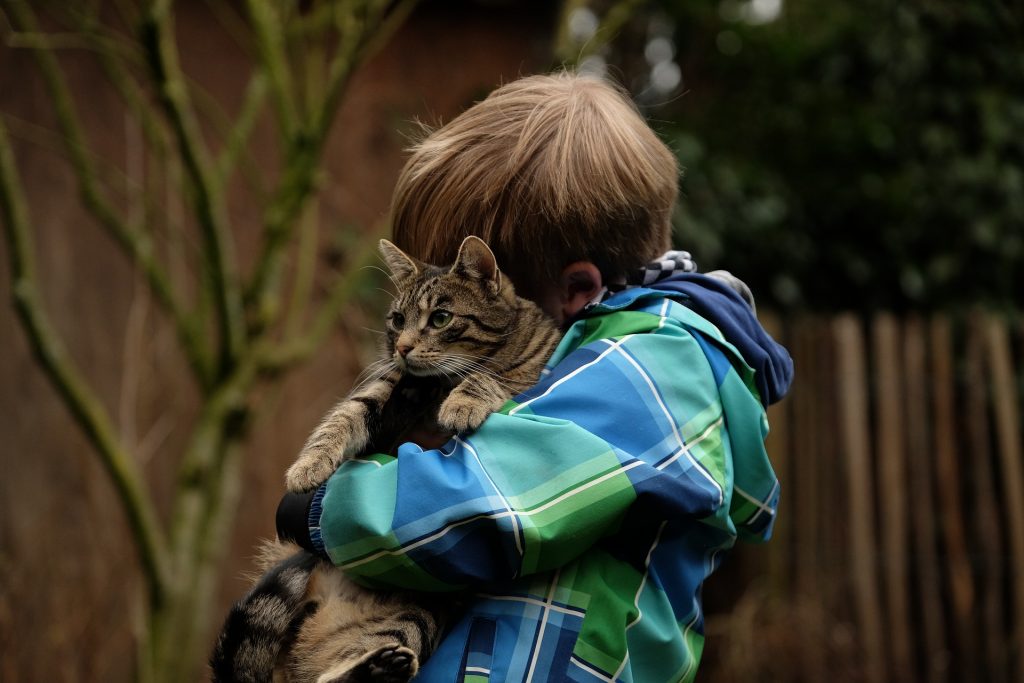Growing up, my family always had cats. I was an extremely shy child, and my cats were my companions, playmates, and confidantes. I cherish the memories of time spent with my beloved pets, who never questioned me and always accepted me for who I was.
Pets have so much to offer families — love, joy and a lifetime of fun memories. But they can also teach children about responsibility, self-esteem and healthy living habits. If you’re considering adding a pet to your family, here are some of the potential benefits you can expect for your kids.
With pets in the home, there are many opportunities for children to learn these valuable life lessons:
- A sense of self. A dog or cat is a companion, sometimes 24 hours a day. A friendly, well-socialized dog will likely reflect constant love back to the child, saying in effect, “You are a wonderful person, and I love you.” An affectionate cat that’s not fearful will usually send children a similar message. While such a gift can be happily received by a person of any age, for kids, a pet can play a role in helping them form a healthy sense of self and build self-esteem and confidence.
- Behavioral awareness. On the other hand, it’s important for parents to teach children to notice and pay attention to how their behavior affects their pets. Under parental guidance, children can fine-tune and control behaviors and see when the pet’s responses improve as a result of more gentle and respectful treatment.
- Responsibility. Caring for a pet is a great way for children to learn responsibility. But often, parents expect too much from the beginning, which can overwhelm kids and leave parents to feed and walk the pet. For some families, the end result could even be giving up the pet. To avoid that, take a more reasonable approach: Instead of expecting a child to be responsible for daily pet care, start slowly, allowing them a chance to play together and bond. The role of caregiver can then naturally develop (along with some gentle reminders from mom and dad).
- Healthy living habits. Properly caring for pets means feeding them an appropriate diet and engaging them in regular exercise. By being involved with these aspects of care, children can learn healthy living habits for both their pet as well as themselves and recognize the benefits.
- Leadership skills. When children learn to give basic commands to a dog, reward correct behavior and refuse attention for incorrect responses, they’re practicing leadership. This helps them gain confidence in their abilities and a sense of authority, also instilling patience and fairness.
- How to cope with loss. Although many parents probably don’t want to think about this, the lifespan of a dog or cat is considerably shorter than that of people. Larger dogs can have even shorter lifespans. Commonly, a child’s first experience with the death of a loved one is the loss of a beloved pet. If managed in a respectful way that pays tribute to the pet, this experience can be invaluable to children as they prepare for life, and loss.
Age considerations
Of course, children differ in their personalities and responses to experiences, as do pets. Parents may be surprised when one child in the family readily interacts with a pet while another child seems relatively indifferent to the cat or dog. Observing your child’s interests provides a solid starting point for fostering a healthy child-pet relationship.
But whether they’re close or not, any child can benefit from familiarity with pets. This relationship lets children learn something about canine and feline behavior, helps them feel comfortable around other pets and teaches them to interact safely with animals. Children can expand their activities with their cat or dog as appropriate for their age and circumstance. It is vitally important to remember that young children should never be left unattended with a dog or cat. Keep the following in mind.
Toddlers
Young kids are often naturally attracted to animals. Because they don’t know any better, they will follow a pet, perhaps roughly interacting with it. When a young child is unpredictable and moves suddenly, pets can become irritable or fearful of the child. Thus, a first goal should be to teach your child how to safely interact with your cat or dog. You as a parent can work on coaching the child on how to gently and softly approach the cat or dog while also getting the pet to feel comfortable around the child. This requires that your family pet be a cat or dog that’s friendly and tolerant of a young child’s sometimes erratic behavior.
The whole family should spend some quality time with any animal you’re considering. Most pet-adoption shelters can offer counseling and give more detailed information about individual pets’ personalities, as well as their care and upkeep requirements. Children need to learn the parts of the body to touch, the type of touch to use and not to overdo petting.
As a child ages and matures, more responsibility can be delegated. Depending on the pet, with adult supervision and guidance, older children may be able to assist with more complicated tasks such as grooming or walking.
Preteens
The ages of 7 to 12 can be an ideal range for pets and children, because children are at a place in their cognitive development where they can be taught how to safely interact with pets and understand concepts like friendship, sharing and playing. Children especially value having their own pets and taking on more pet responsibilities as their relationship evolves. As children mature and show more ability to handle responsibility, you can add duties such as feeding, brushing and bathing the pet. Of course, adults should oversee the pet’s care because even children who seem mature are still children who need guidance and support.
The relationship between pet and child can be especially influential for only children or those who are the youngest of several siblings. These kids can gain an experience they might not otherwise get: Caring for a smaller individual as they seek out opportunities to nurture. They also often spend more time with pets, sleeping with and talking to them more than with siblings. I was the youngest of three, with a six and eight year difference in-between. I was often excluded from the activities of my older siblings, and my pets filled that void of occasional loneliness and isolation.
No matter their age or birth order, children stand to gain much from their relationship with a pet. While it’s unrealistic to turn over daily responsibilities to a young child, pets do offer opportunities for teaching children useful lessons, and having fun. And with the right expectations, your family can be richer and more fulfilling for including both two- and four-legged members.
Dog bless.
Resource: Vetstreet.com

Judy Endo is the author of Paws-itive Pet Tales. A lifelong resident of the Wilkes-Barre area, she has been a professional dog trainer/competitor as well as a lifetime animal lover and strong supporter of animal rescue. Contact: judyendo@outlook.com




